African Explorer Safari
Waterberg/Mashatu South Africa: (IT-BORT05E)
URL: https://www.hiddentrails.com/tour/south_african_explorer_horse_safari.aspx
Introduction
Waterberg/Mashatu
South Africa
The African Explorer is one of the most varied African safaris, as it goes to two countries (Botswana and South Africa) in one trip and covers a lot of different topography and terrain, combined with excellent and wide ranging game viewing.
This safari gives international horse lovers a chance to explore the rugged central highlands of the Waterberg mountain range of South Africa and the vast Mashatu Game Reserve of Botswana's Tuli Block, known as the "Land of the Giants," due to the large presence of the "giant" wildlife: The African Elephant, the Lion, the Giraffe, the Eland, the Ostrich, the Kori Bustard, and the iconic Mashatu aka Baobab Tree! Spend four nights at a safari camp that has been built high up in the bushveld above the Matlapeng Valley before transferring over the Pont Drift border and the mighty Limpopo River into Botswana for a turn at camping in lion and elephant country!
In the late 19th century Ted Davidson, one of the first members of the pioneering Baber family to settle in the Waterberg, was a young man trading by ox wagon to remote cattle outposts of a young ranching area. Living in the Waterberg meant a life by the campfire! Triple B Ranch has captured this early camp atmosphere in their re-creation of Camp Davidson, and this is where your African horseback adventure begins. The wilderness here soon becomes a great stepping stone to your next adventure; the second half of your safari takes you north, into the Limpopo Valley in the Tuli Block in Botswana. The riding trails here cover both the riverine terrain and the mopane bushveld, including the stunning sandstone formations of the Tuli. The area is famous for its elephant herds, but you should also see many sprightly species of antelope both small and large, skittish zebra herds, roaming wildebeest (gnus), skulking hyena, lounging lions, mischievous baboons, vervet monkeys, lurking crocodiles and water monitors, and it is possible (but a sometimes a bit harder) to find the leopard, cheetah, and wild dogs here as well!
Both camps provide high quality tent accommodations with comfy cots complete with pillows and linens and raised securely off the ground on wooden platforms. Each tent has a private en-suite bathroom (with plumbing). The food is plentiful and delicious, the drinks are merry, and the hospitality is superb! The guides are knowledgeable locals who love to share their passion for horses and their countryside with you!
Accomodation
Accommodations
This is a wilderness ride, so nights will be spent in different locations.
Description
You will be staying at different deluxe bush camps and a luxury lodge.
All camps offer 5 spacious and comfortable A-frame tents all built on raised decks equipped with beds, sheets, and duvets, making for very comfortable camping. Each tent has an ensuite bathroom area with hot water showers (water heated on the fire and placed in a 15 lt camp shower when you are ready) and jug and basin hand wash facilities. There are flushing toilets at Camp Davidson in South Africa, whereas in Botswana toilets are long drop eco toilets.
Solar lights and lanterns are used at both locations as there is no electricity.
A laundry service is offered once in the week in South Africa but not in Botswana. Clients will need to have enough clothing to last 3 days.
There is a limited WiFi and cell service in South Africa and Botswana. If you want to buy a local sim on arrival the one to buy would be MTN.
Accommodation Itinerary - subject to changes based on availability
Night 1 - 3: Camp Davidson (South Africa)
Night 4: Bellevue Lodges / Savannah Lodge (South Africa)
Night 5 & 6: Two Mashatu Camp (Botswana)
Night 7: Tree Camp (Botswana)
Accommodation Itinerary for Special Program - subject to changes based on availability
Night 1 & 2: Camp Davidson (South Africa)
Night 3: Bellevue Lodges / Savannah Lodge (South Africa)
Night 4: Tree Camp (Botswana)
Night 5 & 6: The Kgotla (Botswana)
Night 7: Tree Camp (Botswana)
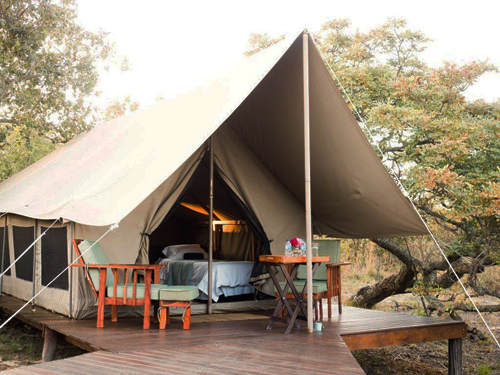
Camp Davidson
A re-creation of the original Camp Davidson has been built high in the bushveld above the Matlapeng valley. It offers the opportunity to explore on horseback from a secure base camp nestled in the heart of the wooded mountains and commands a wonderful panoramic view of the central highlands of the Waterberg range, while overlooking the picturesque Sunset Lake at the eastern boundary of the ranch property. Stay in decked canvas tents nestled amongst the sandstone ridges overlooking grassy valleys. Each luxury tent has an en-suite bathroom.
The camp is completely run on solar energy and has a small swimming pool.
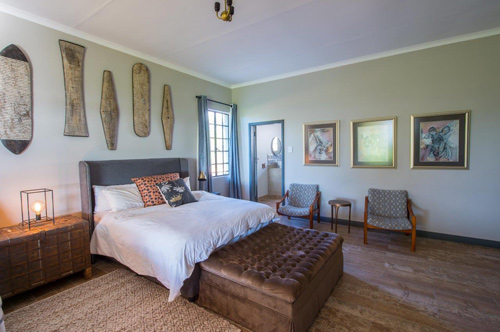
Bellevue Lodges / Savannah Lodge
This luxury lodge is within a morning's ride from Camp Davidson and offers excellent riding and plenty of game. It is located on the south western side of the conservancy and is tastefully decorated lodge with 5 en-suite rooms. The lodge had a large comfortable living space and dining areas inside and outside.
There is a small pool and deck which overlooks a plain and watering hole close by, where wildlife can frequently be seen.
There are no Wi-Fi facilities at the lodge.
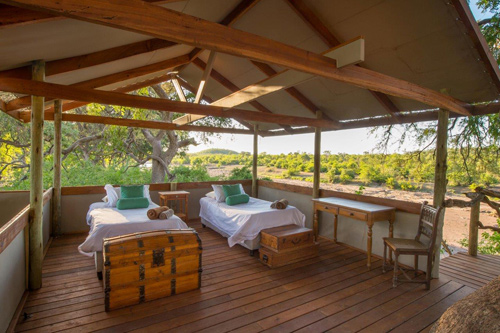
Tree Camp
This is a very unique camp. Nestled in the bough of a giant Mashatu tree and two ancient Leadwood trees, this Seligna deck, 4 meters off the ground, will be your retreat for the night. Two guests each share an airy and cool sleeping pod. Along a short walkway, shared showers and toilets are under the Leadwood trees.
The spacious dining and lounge area flow from the sleeping pods and overlook the Majale River.
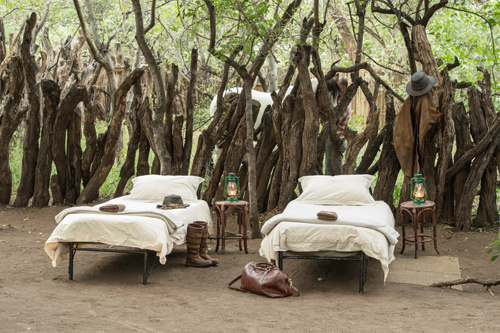
The Kgotla
The Kgotla is an old tribal court from a nearby community, which was relocated to the banks of the Motloutse River on the western periphery of Mashatu. The boma is an open-air traditional African enclosure made up of a circle of Leadwood logs. The camp has hot running water, beautiful open-air showers and flushing toilets (shared): the perfect combination for comfort and an authentic bush experience. Guests sleep on single beds around a large log fire in the center of the enclosure.
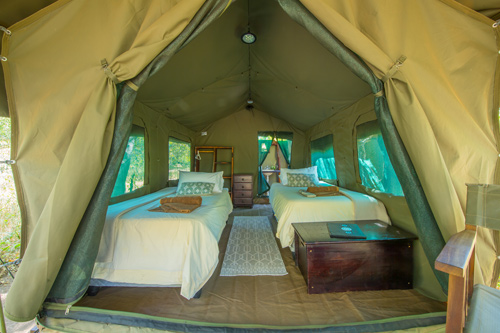
Two Mashatus Camp
Nestled in the shade of two large Mashatu trees, the heart of the camp has two traditionally built Lala Palm rondavels for dining and lounge areas.
Guest accommodation is in large A-frame walk-in tents set on teak platforms each with en-suite enviro drop toilet and hot water shower. Each tent is private and positioned in the shade of a tree in the bush, not far from the main area. Each tent has a small deck area in front where guests can relax privately during the afternoons.
Two Mashatus Camp also has a small swimming pool under a Mashatu tree for guests to enjoy.
Room Occupancy
Triple occupancy is possible.
If you are willing to share, the single supplement fee does not apply.
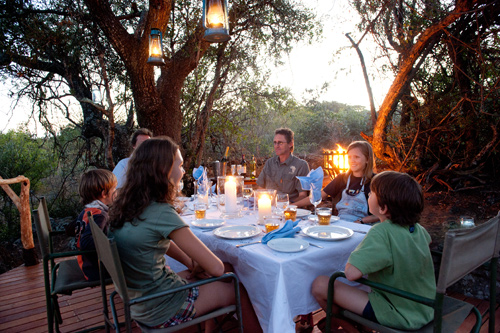
Meals
All meals are included from lunch on Day 1 to brunch on your last day.
Two highly trained experienced bush chefs will look after your every need.
Breakfast is buffet of cereals, toast, muffins, or porridge.
Lunch is a buffet usually quiches, salads, fruits, and dessert.
Dinner is a 3 course meal served to you at the table, often under the canopy of stars!
All water in the camp is filtered to the highest standards and is guaranteed perfectly safe for drinking. All drinks are included with your tour.
Please also advise us if any guests will be celebrating a birthday or special occasion, that you may want us to be aware of to help plan something special!
Dietary Restrictions
We can cater to dietary restrictions if given prior notice.
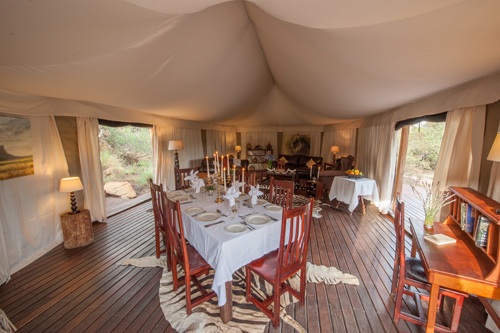
This trip includes
some wine with dinner
and can accommodate special dietary requests.
Riding
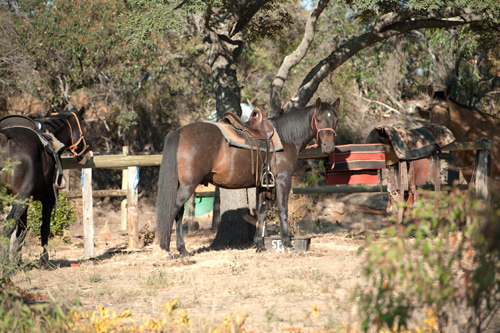
Riding Experience
Guests must be experienced riders. They must ride regularly (at least once or twice a week) and be comfortable at posting trot, light seat canter and gallop as well as being able to do small jumps should they have to. They must be able to control a horse independently of the group at all paces.
On arrival in Botswana, you will be asked to do a simple independent riding test. The guides in South Africa will be able to assess your riding skills and will advise on your suitability to ride in Botswana. Should they deem you not able to ride in Botswana you will stay at the lodge for the three days and carry on with the safari riding.
Horses
We have a herd of 96 horses in South Africa and 53 horses in Botswana. The herd is comprised of Boerperds, Throroughbreds, Warmbloods and Arab crosses. They range in size from 14.3hh to 17 hh. Their schooling generally concentrates on English style, although the horses neck rein when in the bush. They respond easily and lightly to the aids.
All of the horses have been individually selected for their temperament and "ride-ability" on safari. They are from the various South African breeds, which are well known for being of a hardy nature and able to cope under extreme conditions. Our safari horses have been hand selected for their endurance, courage and responsiveness.
Our philosophy has entailed managing our horses as a free roaming herd within large tracts of natural pasture, rather than in stables or paddocks. Our horses are at ease with each other and within their environment, which generates calm and contented natures. As a result, we can offer our guests responsive, subtle and honest rides.
Tack
Saddles are South African McClellan’s, a cavalry saddle designed for long hours of riding, they offer particular comfort and airflow for the horses back and padded seats and fenders for the rider's comfort.
Guides & Safety
Guides leading the safari have many years’ experience and most have grown up in the area and know the bush like the back of their hand. Our guides have either professional or assistant guiding licenses with the Botswana Qualifications Authority. They are qualified to use firearms and qualified in first aid.
All rides are conducted by two experienced professional guides. The lead guide is armed with a rifle and a bull whip. All management staff and guides do regular first aid training with a specialized doctor for remote areas. The lead guide has a local phone and a radio for use in emergencies.
Hard Hat
Hard hats are compulsory and you will not be able to ride without one. We can provide helmets (limited quantities), but suggest that clients bring their own. We do not provide half chaps but might have the odd pair should clients need.
Non-Riders
Non-riders are welcome on this trip. One very good option is to relax by the pool with a good book taking in Africa. For the more active there are excursions available at additional fees. South African Excursions include, guided hike, ziplining, elephant riding, local town and township visit and big five game drives. Whilst in Botswana, non-riders can do a morning guided bush walk, or cycle (min 2 pax). Afternoons in Botswana will be a drive to camp on the first day, a guided walk with the group on the second day a full Mashatu game drive and on the last afternoon.
Itinerary
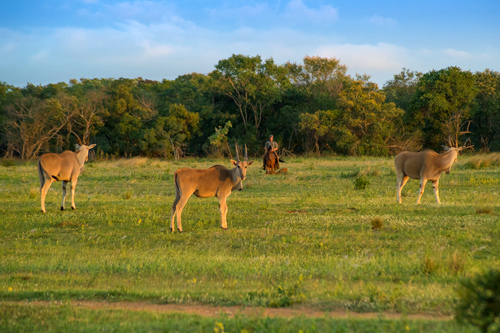
IMPORTANT NOTE:
Before we can confirm your booking, we will need all riders to send a video of themselves riding on the flat, including upwards and downwards transitions between walk, trot and canter and changes of direction.
On the first afternoon ride in South Africa, there will be a short, simple riding test out in the bush. Guests will be asked to take part in a single file group canter. Then they will ride their horse away from the group between three points, varying the pace between a collected and an extended canter. The first exercise is to demonstrate that the rider is able to control their horse at an even pace within a group canter, without overtaking or allowing large gaps to develop within the group. The second is to demonstrate their ability to control their horse independently from the group.
Those that fail will not be allowed to ride in the group. They will be brought down to the lodge once a day for a smaller, slower ride, either on their own or with other riders of similar ability staying in the lodge. They will not be allowed to ride to Savannah or Seringa Lodges.
There will still be a test in Botswana and someone who passes in South Africa may still fail the Botswana requirements. Those who fail the test in South Africa will not be able to ride in Botswana.
Sample Itinerary - subject to changes
4 nights in South Africa and 3 nights in Botswana
No game drive is included in this package. However, it is possible to book a Game Drive in Mashatu for an extra fee (subject to availability).
NOTE: Please note that due to changes in weather and other unforeseen events, the itinerary and accommodation used may change at the last minute.
Day 1 (Friday): Arrival
ARRIVAL: Clients to land by 9h30. Latest meeting time at the info desk arrival hall is 11h00. (Exact meeting time will be advised prior to arrival) Arrive at camp for late lunch.
Guests are personally met at OR Tambo Airport in South Africa by representatives of our sister company, Saddlebag Shuttles, and transported directly to Camp Davidson in the Waterberg, where they will enjoy a light lunch overlooking the vastness of the Waterberg plateau. They will then receive a safety briefing and meet their horses.
Our team takes great care to match horse to rider based on a guest’s riding experience and professed ability. The horses are predominantly boerperds, together with a mixture of warmbloods, Appaloosas and Friesians. They are all well schooled, forward going but calm horses. It is crucially important for the safety and enjoyment of the whole group that riders wishing to book the African Explorer are at least intermediate riders. While the journey is not an endurance test, it does involve long hours in the saddle and, with the possibility of close encounters with elephant and the big cats in Botswana, riders need to be able to control their mounts gently and confidently.
The first ride is a gentle introduction to the reserve and an excellent opportunity for first encounters with species such as zebra, giraffe, wildebeest and kudu. The riding ranges from purposeful walking to easy cantering along sandy tracks and culminates with sundowner drinks on the open plains.
Meals included: Lunch & Dinner
Overnight at Camp Davidson
Day 2 (Saturday): Camp Davidson
The ride this morning is generally quite fast. The route follows the centre of an open valley which is home to species such as sable, reedbuck, red hartebeest, waterbuck and impala. The sandy tracks make for excellent going, and the route crosses open grassland and weaves through dense woodland.
Dark red pedigree cattle bred on the property are often encountered on this route. When conditions are suitable, the last stretch of the ride involves splashy canters along the edge of the lake adjacent to Horizon Lodge. This is a great experience, but don’t expect to remain dry in the process!
The afternoon ride follows past a series of dams where encounters with hippo are likely and returns across the open plains. At this time of day there is often much activity on the plains, with the herds mingling in the soft sunlight and different groups coming and going as they prepare for the night. It is a truly magical experience to be able to ride so close to these wild animals, which have become completely relaxed in the presence of the horses.
Meals included: Breakfast, Lunch & Dinner
Overnight at Camp Davidson
Day 3 (Sunday): Camp Davidson
Setting off in a westerly direction, this ride tracks past a brown hyena den, skirts past the upper reaches of the Horizon dam before crossing a wide grassy valley. At one point the ride enters into dense woodland, home to shy species such as kudu, bushbuck and Vervet monkeys. Emerging from the woods, the horses have a chance to stretch their legs along open sandy tracks. Finally the ride swings back to the north, through mixed bushveld and fascinating rock formations. Two highlights of this ride are the jumping lanes and the chance for riders to swim their horses bareback in the Horizon dam next to the main lodge. For many guests, this is an exhilarating and unforgettable experience. Once dried off and back in the saddle, the ride climb back up to Camp Davidson is particularly intriguing, as it follows a mountain pass cut through boulders and outcrops. After lunch, enjoy a sundowner ride across the plains on the reserve. We are very fortunate to have a large herd zebra. Over the years, the herd has become quite habituated to the horses and it is now possible to ride really close and experience being part of the zebra herd. A wonderful way to watch the foals frollick.
Meals included: Breakfast, Lunch & Dinner
Overnight at Camp Davidson
Day 4 (Monday): Camp Davidson to Savannah Lodge
An early start is needed for the long ride from Camp Davidson to either Savannah Lodge in the far southwest of the reserve, or Seringa Lodge in the southeast. The first part of the route covers country that riders will now be somewhat familiar with, but soon enters new terrain. In places the bush is thick but after a while the scenery opens to grasslands with sweeping views to the south and west. Riding through this landscape gives riders a sense of the vastness of the African plains. The area boasts a very high concentration of game with herds of over 300 blesbuck, or 80 eland, often sighted. Other species which are home to the plains include red hartebeest, tsessebe and ostrich. There are plentiful zebra, wildebeest, impala and giraffe, and smaller groups of sable, roan and waterbuck. The final stretch to Savannah Lodge is along a wooded stream where kudu and bushbuck are likely to be seen.
After a relaxing time around the pool and within the sophisticated lodges, it is time to ride to the southern most areas of the reserve in search of Cape buffalo. These are members of Africa’s famous “big five” and deserve their formidable reputation. Riders therefore need to be alert and responsive to the guides’ instructions. This area is known for its spectacular sunsets as the sun sets over the distant headlands of the Waterberg escarpment – a fitting end to an eventful and memorable day in the African wilderness.
Meals included: Breakfast, Lunch & Dinner
Overnight at Savannah Lodge
Day 5 (Tuesday): Road Transfer to Botswana
Morning:
After an early start, another long ride through game rich country returns riders to the heart of the operation, Horizon Lodge. The route taken is different from that taken on the outward leg, turning this part of the safari into an exciting journey passing through diverse landscapes and ecosystems. Game species typically prefer different habitats, with nyala and bushbuck for instance occupying dense forest-like sections of the reserve while blesbuck and hartebeest stick to the open plains, and waterbuck and reedbuck, unsurprisingly, are normally seen close to streams and other waterways. The route provides excellent opportunities to see giraffe, which is always a highlight. At the Horizon Lodge, guests embark on the road transfer to Mashatu Game Reserve in Botswana with Saddlebag Shuttles.
Afternoon:
Having crossed the mighty Limpopo River, guests are received at the Horizon Horseback Mashatu Stables where they will enjoy a light lunch, receive a safety briefing, and meet their horses.
The route on this afternoon is from the Stables to Two Mashatus Camp, a distance of 11km. It follows the Limpopo River floodplains, with good opportunities for those first exciting encounters with elephant, giraffe, zebra, ostrich and wildebeest. The route crosses close to a large wetland area which acts as a magnet for game and there is even a chance to come across bat eared fox, black backed jackal and spotted hyena. It then crosses the Majali River close to its confluence with the Limpopo, a favourite haunt of leopards and a resident pride of lion. Across an open plain the famous Two Mashatus Camp awaits.
Meals included: Breakfast, Lunch & Dinner
Overnight at Two Mashatus Camp
Day 6 (Wednesday): Game Ride & Optional Game Drive
The riding explores the game rich area along the Majali and Pitsani Rivers. In the north there are open plains. Overall the riding is relaxed, with the guides responding to the herds whilst keeping their eyes peeled for the big cats. In the afternoon there is the option of a bush walk or a shorter ride, maybe to the banks of the Limpopo River where elephants are often seen crossing.
Meals included: Breakfast, Lunch & Dinner
Overnight at Two Mashatus Camp
Day 7 (Thursday): Two Mashatus to Tree Camp
On this day the journey turns northeast and follows a series of river trails on the way back to the centre of the reserve. Life in this arid environment is always concentrated near water, and the ride promises sightings of elephant, zebra, giraffe and wildebeest. The route crosses the watershed and then winds along ancient paths adjacent to a stream flowing north towards the Majali River. At these elevated heights, the sweeping views to the north reveal the true wilderness character of Mashatu Game Reserve. The remainder of the day’s riding is a mixture of elephant trail trekking and canters across relatively open mopane veld. The final stretch is along the Majali River itself, past rocky pools, cliff faces and ribbons of green grass. Encounters with baboon, kudu, klipspringers and crocodile are likely. Tree Camp is finally reached after 4-5 hours of riding.
That afternoon guests leave their horses to a well-earned rest and will go either on a guided bush walk or, if the group chooses, a game drive with Mashatu Main Camp guides. This opportunity, while provided at an extra cost, should not be missed as the near guaranteed sightings of lion and leopard, and sometimes of cheetah, are legendary. The guides are very knowledgeable about the structure and whereabouts of the various prides and individuals, and failure to find them is very rare indeed.
Meals included: Breakfast, Lunch & Dinner
Overnight at Tree Camp
Day 8 (Friday): Departure
After a quick breakfast, riders set off on the final ride of the safari. This ride offers sweeping views to the east and south, bathed in early morning light, as it traverses along the edge of a ridge near the centre of the reserve. The path then descends to a game rich area along the Majali River. The deep river pools are the favourite haunt of baboon and impala. Sooner or later the great herds of elephant come past for their daily drink, to play in the water and enjoy a dust bath.
The final part of the ride is across open plains with some fast canters to the Stables. Other notable sightings include Kori Bustard, the largest flying birds in Africa, bat eared foxes and ostrich.
Once at the Stables it time for a shower and meal on the banks of the great river, and then a short journey to the Limpopo Valley Airfield for the flight to Johannesburg in South Africa.
DEPARTURE: fly out of LVA by plane at 13h30, into Lanseria approximate arrival ORT by 16h30.
IMPORANT: Please book flights departing after 20h00 to allow for delays or a change to a road transfer in the case of bad weather.
Meals included: Brunch
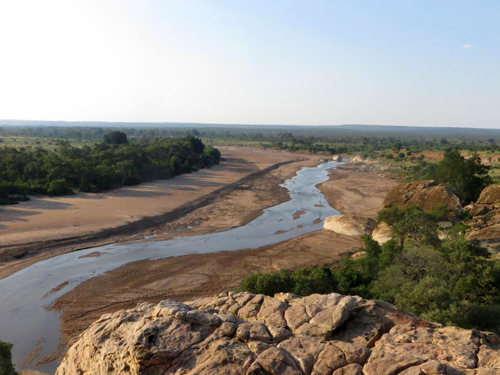
Sample Itinerary: SPECIAL - subject to changes
3 nights in South Africa and 4 nights in Botswana
No game drive is included in this package. However, it is possible to book a Game Drive in Mashatu for an extra fee (subject to availability).
NOTE: Please note that due to changes in weather and other unforeseen events, the itinerary and accommodation used may change at the last minute.
Day 1 (Tuesday): Arrival
ARRIVAL: Clients to land by 9h30. Latest meeting time at the info desk arrival hall is 11h00. (Exact meeting time will be advised prior to arrival) Arrive at camp for late lunch.
Guests are personally met at OR Tambo Airport in South Africa by representatives of our sister company, Saddlebag Shuttles, and transported directly to Camp Davidson in the Waterberg, where they will enjoy a light lunch overlooking the vastness of the Waterberg plateau. They will then receive a safety briefing and meet their horses.
Our team takes great care to match horse to rider based on a guest’s riding experience and professed ability. The horses are predominantly boerperds, together with a mixture of warmbloods, Appaloosas and Friesians. They are all well schooled, forward going but calm horses. It is crucially important for the safety and enjoyment of the whole group that riders wishing to book the African Explorer are at least intermediate riders. While the journey is not an endurance test, it does involve long hours in the saddle and, with the possibility of close encounters with elephant and the big cats in Botswana, riders need to be able to control their mounts gently and confidently.
The first ride is a gentle introduction to the reserve and an excellent opportunity for first encounters with species such as zebra, giraffe, wildebeest and kudu. The riding ranges from purposeful walking to easy cantering along sandy tracks and culminates with sundowner drinks on the open plains.
Meals included: Lunch & Dinner
Overnight at Camp Davidson
Day 2 (Wednesday): Camp Davidson
The ride this morning is generally quite fast. The route follows the centre of an open valley which is home to species such as sable, reedbuck, red hartebeest, waterbuck and impala. The sandy tracks make for excellent going, and the route crosses open grassland and weaves through dense woodland.
Dark red pedigree cattle bred on the property are often encountered on this route. When conditions are suitable, the last stretch of the ride involves splashy canters along the edge of the lake adjacent to Horizon Lodge. This is a great experience, but don’t expect to remain dry in the process!
The afternoon ride follows past a series of dams where encounters with hippo are likely and returns across the open plains. At this time of day there is often much activity on the plains, with the herds mingling in the soft sunlight and different groups coming and going as they prepare for the night. It is a truly magical experience to be able to ride so close to these wild animals, which have become completely relaxed in the presence of the horses.
Meals included: Breakfast, Lunch & Dinner
Overnight at Camp Davidson
Day 3 (Thursday): Camp Davidson to Savannah Lodge
An early start is needed for the long ride from Camp Davidson to either Savannah Lodge in the far southwest of the reserve, or Seringa Lodge in the southeast. The first part of the route covers country that riders will now be somewhat familiar with, but soon enters new terrain. In places the bush is thick but after a while the scenery opens to grasslands with sweeping views to the south and west. Riding through this landscape gives riders a sense of the vastness of the African plains. The area boasts a very high concentration of game with herds of over 300 blesbuck, or 80 eland, often sighted. Other species which are home to the plains include red hartebeest, tsessebe and ostrich. There are plentiful zebra, wildebeest, impala and giraffe, and smaller groups of sable, roan and waterbuck. The final stretch to Savannah Lodge is along a wooded stream where kudu and bushbuck are likely to be seen.
After a relaxing time around the pool and within the sophisticated lodges, it is time to ride to the southern most areas of the reserve in search of Cape buffalo. These are members of Africa’s famous “big five” and deserve their formidable reputation. Riders therefore need to be alert and responsive to the guides’ instructions. This area is known for its spectacular sunsets as the sun sets over the distant headlands of the Waterberg escarpment – a fitting end to an eventful and memorable day in the African wilderness.
Meals included: Breakfast, Lunch & Dinner
Overnight at Savannah Lodge
Day 4 (Friday): Transfer to Botswana
Morning:
After an early start, another long ride through game rich country returns riders to the heart of the operation, Horizon Lodge. The route taken is different from that taken on the outward leg, turning this part of the safari into an exciting journey passing through diverse landscapes and ecosystems. Game species typically prefer different habitats, with nyala and bushbuck for instance occupying dense forest-like sections of the reserve while blesbuck and hartebeest stick to the open plains, and waterbuck and reedbuck, unsurprisingly, are normally seen close to streams and other waterways. The route provides excellent opportunities to see giraffe, which is always a highlight. At the Horizon Lodge, guests embark on the road transfer to Mashatu Game Reserve in Botswana with Saddlebag Shuttles.
Afternoon:
Having crossed the mighty Limpopo River, guests are received at the Horizon Horseback Mashatu Stables where they will enjoy a light lunch, receive a safety briefing, and meet their horses.
The route on this afternoon is from the Stables to Two Mashatus Camp, a distance of 11km. It follows the Limpopo River floodplains, with good opportunities for those first exciting encounters with elephant, giraffe, zebra, ostrich and wildebeest. The route crosses close to a large wetland area which acts as a magnet for game and there is even a chance to come across bat eared fox, black backed jackal and spotted hyena. It then crosses the Majali River close to its confluence with the Limpopo, a favourite haunt of leopards and a resident pride of lion. Across an open plain the famous Two Mashatus Camp awaits.
Meals included: Breakfast, Lunch & Dinner
Overnight at Tree Camp
Day 5 (Saturday): Tree Camp to the Kgotla
Waking in Tree Camp is a magical experience. One feels fully immersed in nature, surrounded by birdsong, and alive to the new day as the early morning light filters through the tree’s leaves. After a quick breakfast, riders set off on the journey’s first long ride – up onto the edge of the mini escarpment and then down, through the Valley of the Elephants and on towards the distant sandstone citadels guarding the Limpopo and Motloutse Rivers.
The first part of the journey is not to be hurried, as the horses wind along well worn elephant paths, past giant baobabs and the occasional shallow watering pan. Soon, however, the country opens up and the horses can start to stretch their legs along soft ground leading to the headwaters of a stream flowing off the ridge and down towards the Limpopo. This is prime elephant country and the guides are always on the lookout, using all their sharpened senses. Once the path leaves the river, the terrain is once again more open and the pace faster. A second river is then joined, which leads directly down to the veterinary control gate on the main road through Mashatu Game Reserve.
The route then follows the road for a short while before heading across flat country towards the intriguing Sacred Rock massif. Here the mopane vegetation is short, and it is safe to ride quite fast across the plain. Large herds of zebra, wildebeest and impala inhabit this area. The guides plot their route using individual mashatu, leadwood and apple-leaf trees as their markers. Soon riders reach the old leadwood enclosure (used in the past as a traditional law court of a Botswana village) known as the ‘Kgotla’. This open-air enclosure forms the perfect, secure camp for the night. The camp is not far from the banks of the Motloutse River and, with high concentrations of game living along the river’s fertile floodplain, the area is home to large prides of lion and clans of hyena. The sounds of these predators at night provide enduring memories!
In the afternoon, we search for the area’s resident lion on a game drive and draw the day’s adventures to a close with sundowners at the ancient “Amphitheatre” rocks. Whilst big cat sightings from horseback occasionally happen, Horizon Horseback follows a ride away policy. The best opportunities to approach lion, cheetah, leopard, and spotted hyena occur whilst on game drives where the vehicle acts as a natural hide and is largely ignored by the predators. Back at the Kgotla, dinner is enjoyed around a large fire. The night is spent with a ceiling of stars and Africa’s night-time melody to sing you to sleep; a rare experience which is just about as far away from city life and the modern world as anyone can imagine.
Meals included: Breakfast, Lunch & Dinner
Overnight at The Kgotla
Day 6 (Sunday): Exploring the Motloutse
The riding this day is more relaxed and tailored to the group, since a different camp does not need to be reached by nightfall. A particularly interesting route to follow is first along the Motloutse River, stopping at well-known elephant drinking holes to watch the herds come and go before winding down towards the impressive Solomon’s Wall, a tall dolomite dyke which was breached by the river in ancient times. This is the favourite haunt of troops of baboon, which are always fascinating to watch. The trail then follows the banks of the river, flanked by giant mashatu and leadwood trees, towards the mighty Limpopo. This area is renowned for its dramatic sandstone rock formations, steeped in colour and home to eland, klipspringer and kudu.
Some of the oldest civilizations in southern Africa settled in this valley. Archaeological evidence in the area includes middle and late stone age tools, rock art and the legendary Mapungubwe Dynasty. Mapungubwe means “Place of the Jackal” in the Venda language and this dynasty existed around 1220 AD. The Mapungubwe topography itself is ancient and timeless and, combined with marvelous wildlife sightings, makes for an incredible riding experience.
The game drive in the afternoon takes guests to the foot of the impressive Mamagwa massif, a freestanding formation which was used by British troops as a defensive position against incursions from the Transvaal Boers at the end of the 19th century. Sundowners are traditionally taken at the far western edge of the massif, with endless views over the wilderness landscape whilst watching the sun slowly slip over the horizon. The drive back to Kgotla in the dark provides more excellent opportunities to spot lion, leopard, and hyena.
Meals included: Breakfast, Lunch & Dinner
Overnight at The Kgotla
Day 7 (Monday): The Kgotla to Tree Camp
On this day the journey turns northeast and follows a series of river trails on the way back to the centre of the reserve. Life in this arid environment is always concentrated near water, and the ride promises sightings of elephant, zebra, giraffe and wildebeest. The route crosses the watershed and then winds along ancient paths adjacent to a stream flowing north towards the Majali River. At these elevated heights, the sweeping views to the north reveal the true wilderness character of Mashatu Game Reserve. The remainder of the day’s riding is a mixture of elephant trail trekking and canters across relatively open mopane veld. The final stretch is along the Majali River itself, past rocky pools, cliff faces and ribbons of green grass. Encounters with baboon, kudu, klipspringers and crocodile are likely. Tree Camp is finally reached after 4-5 hours of riding.
That afternoon guests leave their horses to a well-earned rest and will go either on a guided bush walk or, if the group chooses, a game drive with Mashatu Main Camp guides. This opportunity, while provided at an extra cost, should not be missed as the near guaranteed sightings of lion and leopard, and sometimes of cheetah, are legendary. The guides are very knowledgeable about the structure and whereabouts of the various prides and individuals, and failure to find them is very rare indeed.
Meals included: Breakfast, Lunch & Dinner
Overnight at Tree Camp
Day 8 (Tuesday): Departure
After a quick breakfast, riders set off on the final ride of the safari. This ride offers sweeping views to the east and south, bathed in early morning light, as it traverses along the edge of a ridge near the centre of the reserve. The path then descends to a game rich area along the Majali River. The deep river pools are the favourite haunt of baboon and impala. Sooner or later the great herds of elephant come past for their daily drink, to play in the water and enjoy a dust bath.
The final part of the ride is across open plains with some fast canters to the Stables. Other notable sightings include Kori Bustard, the largest flying birds in Africa, bat eared foxes and ostrich.
Once at the Stables it time for a shower and meal on the banks of the great river, and then a short journey to the Limpopo Valley Airfield for the flight to Johannesburg in South Africa.
DEPARTURE: fly out of LVA by plane at 13h30, into Lanseria approximate arrival ORT by 16h30.
IMPORANT: Please book flights departing after 20h00 to allow for delays or a change to a road transfer in the case of bad weather.
Meals included: Breakfast & Lunch
----
Non-Riders
In South Africa an accompanying non-rider can enjoy onsite bush walks and a variety of excursions such as, guided hike pp $30pp, elephant riding $100, local town and township visit $20pp, big five game drives $40pp. (rates subject to changes)
Rates and Dates for African Explorer Safari
Rates include:
Accommodations at Camp Davidson (4 nights) and Mashatu (3 nights) in deluxe bush camps, all meals and drinks, game drives and bush walks, laundry, 7 riding days.
Rates Note:
Only road transfer available from December to February
* prices are per person based on double/twin occupancy
Rates Note:
Only road transfer available from December to February
Transfer and Other Charges:
|
2019
|
Road and Air transfer, pp, roundtrip
|
£
340
|
$460
|
Dates Note:
Rates do not include:
Tourism levy, gratuities (payable only in cash)
Other Info
Meeting: Camp Davidson
Airport: O.R. Tambo International Airport (JNB)
Transfer: O.R. Tambo International Airport (JNB)
Climate:
Polokwane area
|
Month
|
Jan
|
Feb
|
Mar
|
Apr
|
May
|
Jun
|
Jul
|
Aug
|
Sep
|
Oct
|
Nov
|
Dec
|
|
Average High Temperature (°F)
|
84
|
84
|
82
|
79
|
75
|
70
|
70
|
75
|
80
|
82
|
83
|
84
|
|
Average Low Temperature (°F)
|
63
|
62
|
60
|
54
|
47
|
41
|
41
|
45
|
51
|
56
|
59
|
62
|
|
Average High Temperature (°C)
|
29
|
29
|
28
|
26
|
24
|
21
|
21
|
24
|
27
|
28
|
28
|
29
|
|
Average Low Temperature (°C)
|
17
|
17
|
16
|
12
|
8
|
5
|
5
|
7
|
11
|
13
|
15
|
17
|
|
Average Precipitation (days of rain)
|
10
|
8
|
8
|
6
|
1
|
0
|
0
|
0
|
1
|
6
|
10
|
11
|
Source: NOAA
Seasons
The climate over most of Southern Africa is temperate. Hot, dry conditions are usually encountered in the Tuli region. Heavy summer thunderstorms of short duration in the late afternoon and evening may be experienced. Rainfall occurs mostly during the summer months (October - March).
Summer (December to February)
The temperatures are high and there is a lot of humidity in the air. The chances of convectional thunderstorms are great. Some of the summer migrant birds begin to arrive. The characteristic call of the Red-chested Cuckoo rings out clearly, heralding the approach of better times for all. Once good rains have fallen, the small, drab, but extremely vocal Monotonous Lark keeps the bush awake day and night with its irritating call, as they perch on every treetop.
Kudus calve and there is a good chance of seeing late Impala lambs, tottering along on spindly, wobbling legs behind their mothers. Due to the heat, the animals wisely begin to seek shade before 8 o’clock in the morning, only becoming active again in the late afternoon, just prior to sunset. Tropical thunderstorms are a regular afternoon feature and there is a high probability of flooded rivers to add some excitement to game drives.
Autumn (March to May)
The transition from summer to winter occurs rapidly in the Limpopo Valley. Finally the searing heat of summer begins to abate and there is less likelihood of rain. This is a truly splendid time of the year. It is now Autumn and the daily temperatures are most pleasant with balmy days and nights. Temperatures begin to drop rapidly after sunset and both evening and morning game drives require warmer clothing. Although chilly in the morning, the days are clear and pleasant with crisp blue skies. Now that the rains are over, the veldt begins to dry out and game begins to congregate around the major watercourses, such as the Limpopo and associated wetlands, as well as the artificial waterholes scattered throughout the reserve.
A few late Kudu calves may make a bemused appearance in the beginning of March. Large nursery herds of gawky Impala young are found, kept under some control by the watchful eyes of their mothers.
The bush is still dense, but the bright shades of green are starting to become duller as the year progresses. As the vegetation begins to thin, the elusive leopard is more frequently seen. Lions, which dispersed with the game during the wet season, now begin to concentrate their activities in the central area of Mashatu.
Winter (June to August)
Winter is now upon us and has spread its chilly grip on Mashatu. The days are still good, with crisp mornings. The nights can be very cold.
Most of the natural pans and pools have now completely dried up. Elephant and a host of other species begin to frequent the artificial waterholes at both Main and Tent Camps, which makes for exciting mealtime viewing. Predator sightings are good at this time of the year, due to the thinned out vegetation and concentrations of game, cheetah however are scarce. In general the game is more active later into the day.
This is also a favorable time to visit the archaeological site at the Motloutse River. The summer vegetation has disappeared and a host of interesting features are now visible.
Towards the end of winter, the floodplains and grasslands adjacent to the Limpopo are very dry and barren. The bush has become harsh and almost inhospitable, with absolutely no groundcover, only dust and rocks visible for kilometers. The veldt has all the typical winter hues of brown and red, as the Mopane leaves start turning. The weather is fine with temperatures increasing slightly. The early mornings and evenings being not as cold as in June or July. August is a showy month, with respect to sunsets. Due to the very dry conditions, large quantities of dust is taken up into the air, giving rise to spectacular pyrotechnic displays as the sun sinks below the horizon.
Spring (September to November)
The bush is still very dry, a condition exacerbated by winds, which blow from August through to October. Temperatures begin to steadily increase and conditions are becoming desperate for many of the herbivores. This is due to sub region frontal systems touching on the Limpopo Valley, bringing superheated air into the region. There may be an occasional tropical thunderstorm, but this early rain is sucked up like a sponge by the barren earth. This welcome water is however not enough, and seldom results in a notable floral display. Many trees begin to blossom, in anticipation of the rapidly approaching summer. The vibrant hues of the blossoms enliven the bush, providing a bountiful treat for baboons and other hungry inhabitants of the bush, all of whom have struggled through the lean winter months. Temperatures begin to creep upwards and game drives are once again early morning and late afternoon affairs, as a wise means of avoiding the debilitating midday heat.
Predators have a field day, as many of the game are weak and tend to restrict their activities to the area close to the waterholes. The lack of dense vegetation and the dry powdery soil make tracking lion and leopard an easier task and often result in exceptional sightings. Elephant listlessly wait out the dry season, moving from waterhole to waterhole, where they take full advantage, wallowing and drinking for hours. They will feed on the surrounding vegetation, moving into the bush on feeding forays when temperatures have dropped sufficiently for them to forage out of the protective shade. It is also at this time that eland begin to calve.
What To Bring:
Bags have to be soft-sided and weight is limited to 18kg per bag plus 5kg hang luggage. You will be provided with a water bottle for your safari.
When packing, do bear in mind the fact that we offer a free of charge laundry service. A daily laundry service is included at our Signature Safari lodge in South Africa. In Botswana, we offer a laundry service once or twice during your seven-night safari. We can normally turn laundry around within 24 – 48 hours.
Reminder about strict luggage specifications:
As clients are flying out of Botswana please do remember the luggage restrictions of one soft/duffle type bag (max weight:18 kgs / max size: 40x30x60 cm) and one small piece of hand luggage (max 5 kg) per person.
Hard luggage will not be accepted on the flight back! You are allowed to take the plane with your riding gear (boots, hats,...) as well as one power bank per person (up to 100 watt-hour or 20 000 mah) with you in addition to the luggage mentioned above.
Passengers can also have a very SMALL handbag with them for passports and money - but please limit the size of this bag and do not try to squash extra clothing/equipment inside them. The charter planes are much smaller than normal planes and thus have limited space.
Any other cases/bags that do not comply with the above will not be allowed. should you arrive with other types of luggage you will need to transfer your belongings into a plastic bag for your charter flight and your suitcases will be left behind for collection after your safari.
When this happens, guests first come to the lodge in South Africa, where any unsuitable bags can be exchanged for a “China Laundry bag”. We will then hand in the client’s suitcase at ATECK storage in ORTambo for them.
The guest then needs to collect their bag from there, when they return to ORTambo after their safari. Our charter flight provider (Bushwing Charters) will send a message by WhatsApp with a copy of the receipt so the client can collect their bag.
The charge for this service is ZAR 150 – payable in CASH at the lodge before the road transfer up to Botswana.
We recommend bringing the following items:
• Your own well-fitting hard hat - Hard hats are mandatory (we can supply if needed)
• Comfortable riding clothes, this is not the place to test out brand new boots, wear everything a couple of times before bringing it on safari. Neutral colours such as khaki, brown, navy, and green are preferable. Light-coloured garments such as whites and creams should be avoided.
• Short boots and half chaps, ride/walk boot are perfect. Long leather boots are also good but long rubber boots are not advised.
• Bum bag
• Lip salve, hand cream, and moisturiser (it’s dry here!)
• Strong sun protection cream factor 30 or higher
• Mosquito repellent
• Hiking boots or sneakers
• Swimsuit
• Light weight long sleeved shirts
• Camera, memory cards and spare camera batteries
• If you ever suffer from regular bouts of illness e.g. cystitis, sinusitis, eczema, asthma, allergies etc please bring your preferred medication its best to have whatever you may need with you
• Ibuprofen and deep heat are also useful items, especially if you aren’t used to long hours in the saddle
• In our Winter, mornings can be chilly and days hot so bring layers, a vest, shirt fleece and body warmer are ideal winter wear.
• In summer pack a lightweight rain coat
• Books for when you are relaxing between rides
• High lumen torch or head torch
• For Botswana we also recommend a strong power bank of up to a maximum of 20,000 mAh
This may sound strange but if you would like to purchase a spare pack of sanitary items to donate, please do, we donate them to local schools, many girls cannot afford them and have to miss school and exams also if you have any old clothes, shoes, blankets, books or stationary that you would otherwise throw away and have some room in your luggage please do bring it with you. Horizon is involved with local schools and creches and helps where possible with a local outreach project working with the very poor. As such we have lots of people who are grateful for any old clothing. Please do not feel you have to now go out and buy items to bring, - it is not by any means expected - it is just that over the years so many people have expressed regret at not knowing how useful that item they threw away last week would have been to someone here.
|
|